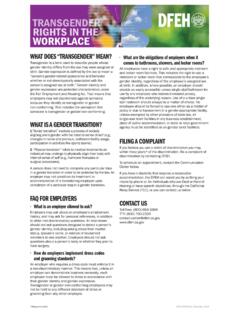Transcription of Transgender Student Guidance for School Districts
1 Transgender Student Guidance for School DistrictsThe New Jersey Law Against Discrimination ( NJLAD ) , 10:5-12(11)(f), generally makes it unlawful for schools to subject individuals to differential treatment based on race, creed, color, national origin, ancestry, marital status, domestic partnership or civil union status, sex, affectional or sexual orientation, gender identity or expression, disability or nationality. Title IX of t he Education Amendments of 1972 ( Title IX ) specifically prohibits discrimination on the basis of sex in federally-funded education programs and activities [20 1681(a)]. 18A:36-41 directs the Commissioner of the New Jersey Department of Education to establish guidelines to provide direction for schools in addressing common issues concerning the needs of Transgender students, and to assist schools in establishing policies and procedures that ensure a supportive and nondiscriminatory environment for Transgender students. This Guidance was prepared by the New Jersey Department of Education after a review of policies and Guidance from other states and organizations, and in consultation with educators, counselors, School psychologists, advocates, and parents.
2 The intended purpose of this Guidance is to help School and district administrators take steps to create an inclusive environment in which Transgender and gender nonconforming students feel safe and supported, and to ensure that each School provides equal educational opportunities for all students, in compliance with 6 et seq. Communication with the Student is paramount. Schools and School Districts are encouraged to communicate openly, albeit confidentially, with students regarding their Transgender status or gender identity. Proper communication with the Student will ensure that appropriate steps are taken to determine a Student s preferences and address potential privacy concerns and associated risks to the Student s well-being. safe and supportive environment within a School begins with understanding and , teachers, and administrators should be provided with common terminology associatedwith gender identity. Although these terms are commonly used by advocacy and human rightsgroups, students may prefer other terms to describe their gender identity, appearance, or behavior.
3 Gender Identity means a person's internal, deeply held sense of gender. All people have agender identity, not just Transgender people. For Transgender people, the individual sinternal gender identity is not the same as the gender assigned at birth. Gender Expression means external manifestations of gender, expressed through a person'sname, pronouns, clothing, haircut, behavior, voice, and/or body characteristics. Societyidentifies these cues as masculine and feminine, although what is considered masculine or feminine changes over time and varies by culture. Assigned Sex at Birth (ASAB) refers to the biological sex designation recorded on a person s birth certificate upon the initial issuance of that certificate, should such a record be provided at birth. Gender Assigned at Birth refers to the gender a child is assigned at birth or assumed to be, based on their biological sex assigned at birth. Sexual Orientation describes a person's enduring physical, romantic, and/or emotional attraction to another person.
4 Gender identity and sexual orientation are not the same. A Transgender person may be straight, lesbian, gay, bisexual, or asexual. For example, a person who transitions from male to female and is attracted solely to men may identify as a straight woman. Transgender is a term for an individual whose gender identity and/or gender expression differs from those typically associated with the sex and gender assigned at birth. Transition is the process by which a Transgender person recognizes that their authentic gender identity is not the same as the gender assigned at birth, and develops a more affirming gender expression that feels authentic. Some individuals socially transition, for example, through dress, use of names and/or pronouns. Some individuals may undergo a physical transition, which might include hormone treatments and surgery. School district personnel should avoid the phrase sex change, as it is an inaccurate description of the transition process; the process is more accurately described as gender-confirming.
5 LGBTQ is an acronym for lesbian, gay, bisexual, Transgender , and queer/questioning. Gender nonconforming describes a person whose gender expression does not conform to the gender expectations of their family or community. Gender nonconformity is not necessarily an indication that a youth is Transgender ; many non- Transgender youth do not conform to stereotypical expectations. Gender Expansive/Gender Diverse/Gender Fluid/Gender Non-Binary/Agender/Gender Queer are terms that convey a wider, more flexible range of gender identity and/or expression than typically associated with the binary gender system. For example, students who identify as gender queer or gender fluid might not identify as boys or girls; for these students, the non-binary gender identity functions as the Student s gender identity. Cisgender refers to individuals whose gender identity, expression, or behavior conforms with those typically associated with their sex assigned at birth. GLAAD, The Human Rights Campaign, and PFLAG also provide comprehensive reference guides on terminology.
6 (See Section 8, Resources) It is recommended that School personnel discuss with the Student the terminology and pronouns each Student has chosen. ApproachA School district shall accept a Student s asserted gender identity; parental consent is not , a Student need not meet any threshold diagnosis or treatment requirements to have his orher gender identity recognized and respected by the district, School or School personnel. Nor is alegal or court-ordered name change required. There is no affirmative duty for any School district personnel to notify a Student s parent or guardian of the Student s gender identity or expression. There may be instances where a parent or guardian of a minor Student disagrees with the Student regarding the name and pronoun to be used at School and in the Student s education records. A parent or guardian may object to the minor Student s name change request. S chool Districts should consult their board attorney regarding the minor Student s civil rights and protections under the NJLAD.
7 Staff should continue to refer to the Student in accordance with the Student s chosen name and pronoun at School and may consider providing resource information regarding family counseling and support services outside of the School district. School Districts should be mindful of disputes between minor students and parent/guardians concerning the Student s gender identity or expression. Many support resources are available through advocacy groups and resources from the New Jersey Department of Children and Families and New Jersey Department of Education's "Child Abuse, Neglect, and Missing Children" webpage. One of the most important factors in ensuring a safe and supportive environment for Transgender students is communication between the School /district and Student . School district personnel should have an open, but confidential discussion with the Student to ascertain the Student s preference on matters such as chosen name, chosen pronoun to use, and parental communications.
8 School Districts shall ensure that a Transgender Student is addressed at School by the nameand pronoun chosen by the Student , regardless of whether a legal name change or changein official School records has occurred. School Districts shall issue School documentation for a Transgender Student , such as studentidentification cards, in the name chosen by the Student . A Transgender Student shall be allowed to dress in accordance with the Student s Districts should discuss with the Student , and any other individuals at the Student s request, the risks associated with the Student s Transgender status being inadvertently disclosed. For example, School Districts should inform the Student that the Transgender status may be revealed due to other students discussions at home. The School district should work with the Transgender Student to ensure awareness of activities and events that may inadvertently disclose the Transgender Student s status. and Supportive EnvironmentEach School district shall develop policies and procedures to ensure that its schools provide a safeand supportive learning environment that is free from discrimination and harassment fortransgender students, including students going through a gender transition.
9 Gender-based policies,rules, and practices can have the effect of marginalizing, stigmatizing, and excluding students,whether they are gender nonconforming or not. All School Districts shall review and update theirexisting policies and procedures, including those regarding classroom activities, School ceremonies, School photographs, and dress codes, to verify that Transgender students are not excluded. In addition, School Districts shall take the following steps to establish and maintain a nondiscriminatory environment for all students, including Transgender and transitioning students: School Districts must comply with 18A:37-15 and 6 , which prohibitharassment, intimidation and bullying, and require that each district board of educationdevelop, adopt, and implement a policy prohibiting harassment, intimidation, or bullying onschool property, at a School -sponsored function or on a School bus. If harassment based ongender identity creates a hostile environment, the School must take prompt and effectivesteps to end the harassment, prevent its recurrence, and, as appropriate, remedy itseffects.
10 School Districts should provide staff training on sensitivity and respect towards transgenderstudents. Social and Emotional Learning (SEL) concepts should be incorporated into School cultureand on SEL can be found on the Department of Education s Social andEmotion Learning webpage( ) School Districts may seek a variety of professionals, including counselors and schoolpsychologists, to provide emotional supports for all students who demonstrate a Districts shall ensure that School counselors are knowledgeable regarding issues andconcerns relevant to Transgender students, students facing other gender identity issues, orstudents who may be transitioning. Dress codes should not be enforced more strictly for Transgender and gendernonconforming students than for other students. School Districts shall honor and recognize a Student s asserted gender identity, and shall notrequire any documentation or evidence in any form, including diagnosis, treatment, or legalname change.








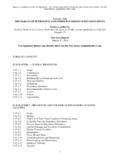
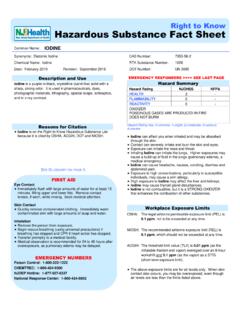


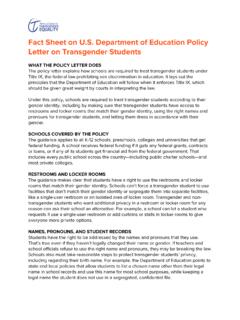
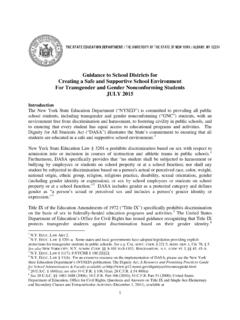
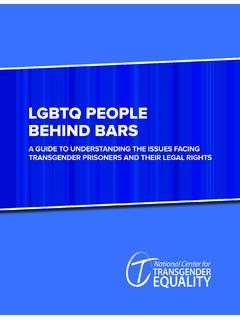
![WELCOME! [www.thetrevorproject.org]](/cache/preview/b/8/d/9/a/1/c/7/thumb-b8d9a1c7785968c282cb5f8ffa51c8c7.jpg)

